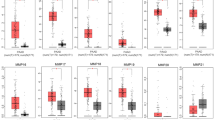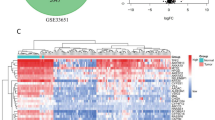Abstract
Gastric cancer (GC) is one of the most common malignancies worldwide. Genes expressed only in cancer tissue will be useful molecular markers for diagnosis and may also be good therapeutic targets. However, little is known about cancer-specific genes, at least in GC. In this study, we searched for GC-specific genes by serial analysis of gene expression (SAGE) data analysis and quantitative reverse transcription (RT)–PCR. Comparing GC SAGE libraries with those of various normal tissues in the SAGEmap database, we identified 54 candidate GC-specific genes. Quantitative RT–PCR analysis of these candidates revealed that APin protein (APIN), taxol resistance-associated gene 3 (TRAG3), cytochrome P450, family 2, subfamily W, polypeptide 1 (CYP2W1), melanoma inhibitory activity (MIA), matrix metalloproteinase-10 (MMP-10), dickkopf homolog 4 (DKK4), GW112, regenerating islet-derived family, member 4 (REGIV), and HORMA domain-containing 1 (HORMAD1) were expressed much more highly in GC than in 14 kinds of normal tissues. Immunohistochemical staining for MIA, MMP-10, and DKK4 was found in 47 (31.1%), 68 (45.0%), and two (1.3%) of 151 GCs, respectively, and staining for both MIA and MMP-10 was correlated with poor prognosis in advanced GC (P=0.0001 and 0.0141, respectively). Moreover, enzyme-linked immunosorbent assay showed high levels of MMP-10 (65/69, 94.2%) in serum samples from patients with GC. Levels of MIA were raised in a small proportion of serum samples from patients with GC (4/69, 5.8%). In Boyden chamber invasion assays, MIA-transfected GC cells were up to three times more invasive than cells transfected with empty vector. Taken together, these results suggest that MMP-10 is a good marker for the detection of GC and that MIA and MMP-10 are prognostic factors for GC. As expression of MIA and MMP-10 is narrowly restricted in cancer, these two molecules may be good therapeutic targets for GC.
This is a preview of subscription content, access via your institution
Access options
Subscribe to this journal
Receive 50 print issues and online access
$259.00 per year
only $5.18 per issue
Buy this article
- Purchase on Springer Link
- Instant access to full article PDF
Prices may be subject to local taxes which are calculated during checkout




Similar content being viewed by others
Accession codes
References
Alley MC, Scudiero DA, Monks A, Hursey ML, Czerwinski MJ, Fine DL et al. (1988). Cancer Res 48: 589–601.
Amatschek S, Koenig U, Auer H, Steinlein P, Pacher M, Gruenfelder A et al. (2004). Cancer Res 64: 844–856.
Bando E, Yonemura Y, Takeshita Y, Taniguchi K, Yasui T, Yoshimitsu Y et al. (1999). Am J Surg 178: 256–262.
Beachy PA, Karhadkar SS, Berman DM . (2004). Nature 432: 324–331.
Blesch A, Bosserhoff AK, Apfel R, Behl C, Hessdoerfer B, Schmitt A et al. (1994). Cancer Res 54: 5695–5701.
Bodey B, Bodey Jr B, Siegel SE, Kaiser HE . (2000). Anticancer Res 20: 4585–4590.
Bosserhoff AK, Echtenacher B, Hein R, Buettner R . (2001). Melanoma Res 11: 417–421.
Bosserhoff AK, Kaufmann M, Kaluza B, Bartke I, Zirngibl H, Hein R et al. (1997). Cancer Res 57: 3149–3153.
Bosserhoff AK, Moser M, Hein R, Landthaler M, Buettner R . (1999). J Pathol 187: 446–454.
Buckhaults P, Rago C, St Croix B, Romans KE, Saha S, Zhang L et al. (2001). Cancer Res 61: 6996–7001.
Clark HF, Gurney AL, Abaya E, Baker K, Baldwin D, Brush J et al. (2003). Genome Res 13: 2265–2270.
Dietz UH, Sandell LJ . (1996). J Biol Chem 271: 3311–3316.
El Fitori J, Kleeff J, Giese NA, Guweidhi A, Bosserhoff AK, Buchler MW et al. (2005). Cancer Cell Int 5: 3.
Hau P, Apfel R, Wiese P, Tschertner I, Blesch A, Bogdahn U . (2002). Anticancer Res 22: 577–583.
Hau P, Ruemmele P, Kunz-Schughart LA, Doerfelt A, Hirschmann B, Lohmeier A et al. (2004). Oncol Rep 12: 1355–1364.
Hembry RM, Bagga MR, Reynolds JJ, Hamblen DL . (1995). Ann Rheum Dis 54: 25–32.
Hohenberger P, Gretschel S . (2003). Lancet 362: 305–315.
Kevorkian L, Young DA, Darrah C, Donell ST, Shepstone L, Porter S et al. (2004). Arthritis Rheum 50: 131–141.
Koga T, Kano T, Souda K, Oka N, Inokuchi K . (1987). Jpn J Surg 17: 342–347.
Kondo T, Oue N, Yoshida K, Mitani Y, Naka K, Nakayama H et al. (2004). Cancer Res 64: 523–529.
Krupnik VE, Sharp JD, Jiang C, Robison K, Chickering TW, Amaravadi L et al. (1999). Gene 238: 301–313.
Lal A, Lash AE, Altschul SF, Velculescu V, Zhang L, McLendon RE et al. (1999). Cancer Res 59: 5403–5407.
Lauren P . (1965). Acta Pathol Microbiol Scand 64: 31–49.
Mantel N . (1966). Cancer Chemother Rep 50: 163–170.
Mao B, Niehrs C . (2003). Gene 302: 179–183.
Mathew R, Khanna R, Kumar R, Mathur M, Shukla NK, Ralhan R . (2002). Cancer Detect Prev 26: 222–228.
Molnar IG, Vandevoorde JP, Gitnick GL . (1976). Gastroenterology 70: 513–515.
Muller D, Breathnach R, Engelmann A, Millon R, Bronner G, Flesch H et al. (1991). Int J Cancer 48: 550–556.
Nakamura H, Fujii Y, Ohuchi E, Yamamoto E, Okada Y . (1998). Eur J Biochem 253: 67–75.
Nelson AR, Fingleton B, Rothenberg ML, Matrisian LM . (2000). J Clin Oncol 18: 1135–1149.
Nomura H, Fujimoto N, Seiki M, Mai M, Okada Y . (1996). Int J Cancer 69: 9–16.
Ohgaki H, Matsukura N . (2003). Stomach cancer. In: Stewart BW, Kleihues P (eds). World Cancer Report. IARC Press: Lyon, p 197.
Oue N, Hamai Y, Mitani Y, Matsumura S, Oshimo Y, Aung PP et al. (2004). Cancer Res 64: 2397–2405.
Oue N, Mitani Y, Aung PP, Sakakura C, Takeshima Y, Kaneko M et al. (2005). J Pathol 207: 185–198.
Poser I, Tatzel J, Kuphal S, Bosserhoff AK . (2004). Oncogene 23: 6115–6124.
Ramos MC, Steinbrenner H, Stuhlmann D, Sies H, Brenneisen P . (2004). Biol Chem 385: 75–86.
Rizvi NA, Humphrey JS, Ness EA, Johnson MD, Gupta E, Williams K et al. (2004). Clin Cancer Res 10: 1963–1970.
Rudek MA, Figg WD, Dyer V, Dahut W, Turner ML, Steinberg SM et al. (2001). J Clin Oncol 19: 584–592.
Saghizadeh M, Brown DJ, Castellon R, Chwa M, Huang GH, Ljubimova JY et al. (2001). Am J Pathol 158: 723–734.
Sharma R, Chattopadhyay TK, Mathur M, Ralhan R . (2004). Oncology 67: 300–309.
Shimizu N, Wakatsuki T, Murakami A, Yoshioka H, Hamazoe R, Kanayama H et al. (1987). Oncology 44: 240–244.
Sobin LH, Wittekind CH (ed). (2002). TNM Classification of Malignant Tumors, 6th edn. Wiley-Liss, Inc.: New York, pp 65–68.
Solomon A, Murphy CL, Weaver K, Weiss DT, Hrncic R, Eulitz M et al. (2003). J Lab Clin Med 142: 348–355.
Thorns V, Walter GF, Thorns C . (2003). Anticancer Res 23: 3937–3944.
Ushijima T, Sasako M . (2004). Cancer Cell 5: 121–125.
Visse R, Nagase H . (2003). Circ Res 92: 827–839.
Yamashita K, Azumano I, Mai M, Okada Y . (1998). Int J Cancer 79: 187–194.
Yasui W, Oue N, Ito R, Kuraoka K, Nakayama H . (2004). Cancer Sci 95: 385–392.
Yasui W, Yokozaki H, Fujimoto J, Naka K, Kuniyasu H, Tahara E . (2000). J Gastroenterol 35: 111–115.
Zhang X, Huang Q, Yang Z, Li Y, Li CY . (2004). Cancer Res 64: 2474–2481.
Zucker S, Hymowitz M, Conner C, Zarrabi HM, Hurewitz AN, Matrisian L et al. (1999). Ann N Y Acad Sci 878: 212–227.
Acknowledgements
We thank M Takatani for excellent technical assistance and advice. This work was carried out with the kind cooperation of the Research Center for Molecular Medicine, Faculty of Medicine, Hiroshima University. We thank the Analysis Center of Life Science, Hiroshima University for the use of their facilities. This work was supported, in part, by Grants-in-Aid for Cancer Research from the Ministry of Education, Culture, Science, Sports, and Technology of Japan, and from the Ministry of Health, Labor, and Welfare of Japan.
Author information
Authors and Affiliations
Corresponding author
Additional information
Supplementary Information accompanies the paper on the Oncogene website (http://www.nature.com/onc)
Supplementary information
Rights and permissions
About this article
Cite this article
Aung, P., Oue, N., Mitani, Y. et al. Systematic search for gastric cancer-specific genes based on SAGE data: melanoma inhibitory activity and matrix metalloproteinase-10 are novel prognostic factors in patients with gastric cancer. Oncogene 25, 2546–2557 (2006). https://doi.org/10.1038/sj.onc.1209279
Received:
Revised:
Accepted:
Published:
Issue Date:
DOI: https://doi.org/10.1038/sj.onc.1209279
Keywords
This article is cited by
-
MIA3 promotes the degradation of GSH (glutathione) by binding to CHAC1, thereby promoting the progression of hepatocellular carcinoma
Molecular and Cellular Biochemistry (2023)
-
A maternal high-fat diet induces fetal origins of NASH-HCC in mice
Scientific Reports (2022)
-
Aberrantly expressed HORMAD1 disrupts nuclear localization of MCM8–MCM9 complex and compromises DNA mismatch repair in cancer cells
Cell Death & Disease (2020)
-
Sensitization of hepatocellular carcinoma cells towards doxorubicin and sorafenib is facilitated by glucose-dependent alterations in reactive oxygen species, P-glycoprotein and DKK4
Journal of Biosciences (2020)
-
Long-term follow-up study of gastric adenoma; tumor-associated macrophages are associated to carcinoma development in gastric adenoma
Gastric Cancer (2017)



